R136a1 is a Wolf-Rayet star located approximately 163,000 light-years away in the southern constellation of Dorado. It is one of the most massive and luminous stars known. With an apparent magnitude of 12.23, the star is invisible to the unaided eye. It lies in the R136 cluster in the Tarantula Nebula, the largest stellar nursery in the Large Magellanic Cloud (LMC).
Star type
R136a1 is a Wolf-Rayet star of the spectral type WN5h. It has 196 times the mass of the Sun and a radius of 42.7 solar radii. With a surface temperature of 46,000 K, it is one of the hottest stars known. It shines with 4,677,000 solar luminosities. The giant star is a very fast spinner, with a projected rotational velocity of 160 km/s.
Wolf-Rayet stars are characterized by unusual spectra with weak or absent hydrogen lines and prominent broad emission lines of ionized helium and nitrogen or carbon.
The “h” suffix in the stellar classification WN5h indicates hydrogen lines in the star’s spectrum. The hydrogen lines indicate that R136a1 is still on the main sequence, fusing hydrogen to helium in its core.
The heavy elements on the star’s surface – helium and nitrogen – are mixed from the core to the surface because more than 90% of the star is convective and because the star is experiencing high mass loss. The mass movement of plasma in the convective zone brings these elements to the surface.
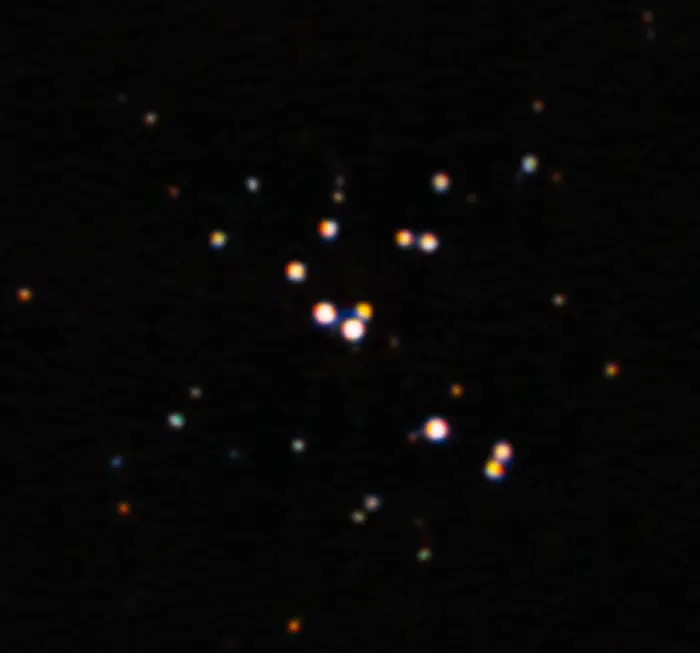
Nestled in the center of the Tarantula Nebula in the Large Magellanic Cloud is the largest star yet discovered. With the help of the Zorro imager and the power of the 8.1-meter Gemini South telescope in Chile, astronomers have produced the sharpest image ever of this star. This new image challenges our understanding of the most massive stars and suggests that they may not be as massive as previously thought.. Image credit: International Gemini Observatory/NOIRLab/NSF/AURA; Image processing: T.A. Rector (University of Alaska Anchorage/NSF’s NOIRLab), M. Zamani (NSF’s NOIRLab) & D. de Martin (NSF’s NOIRLab) (CC BY 4.0)
Even though it is a very distant star, R136a1 is not too obscured by interstellar dust. Without the extinction, it would be about 1.8 magnitudes brighter visually and only 0.22 magnitudes brighter in the near-infrared band.
The star’s distance cannot be measured directly. The value of 163,000 light-years (50 kiloparsecs) is the distance of its host galaxy, the Large Magellanic Cloud. R136a1 is assumed to lie at the same distance.
R136a1 is a member of the R136 cluster in the Tarantula Nebula (30 Doradus). R136 is the central concentration in the larger open cluster NGC 2070 which lies at the centre of the Tarantula Nebula and produces most of the energy that makes the nebula visible.
In 2022, a team of astronomers led by Venu M. Kalari reported the detection of visual companions to R136a1 and its neighbour R136a3 using speckle imaging with Gemini South’s Zorro instrument. The visual companion of R136a1 is a hot, blue O-type star separated by 70 milliarcseconds from R136a1. Astronomers found a 75% chance that the companion is not a chance alignment.
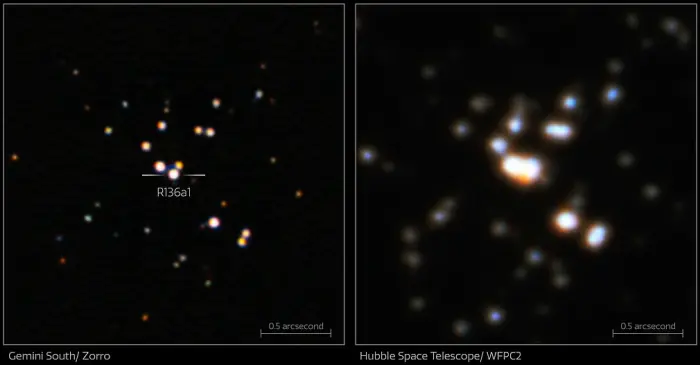
This comparison image shows the exceptional sharpness and clarity of the Zorro imager on the 8.1-meter Gemini South telescope in Chile (left) when compared to an earlier image taken with the NASA/ESA Hubble Space Telescope (right). The new Gemini South image allowed astronomers to clearly distinguish the star R136a1 from its nearby stellar companions, providing the data needed to reveal that – while still the most massive star known in the Universe – it is less massive than previously thought. Image credit: International Gemini Observatory/NOIRLab/NSF/AURA Acknowledgment: Image processing: T.A. Rector (University of Alaska Anchorage/NSF’s NOIRLab), M. Zamani (NSF’s NOIRLab) & D. de Martin (NSF’s NOIRLab); NASA/ESA Hubble Space Telescope (CC BY 4.0)
Size
R136a1 has a radius of 42.7 solar radii, corresponding to 29,700,000 kilometres or about a seventh of an astronomical unit (Earth- Sun distance). The star has a volume almost 80,000 times larger than the Sun.
Unlike the Sun and the Earth, R136a1 does not have a well-defined surface. It has a dense atmosphere that is accelerated outwards in the form of a stellar wind. A point in this wind is taken as the stellar surface and used to define the star’s radius.
Even though it packs a large mass into a modest radius, R136a1 has an average density less than 1% that of the Sun. The star has less than a hundredth the density of water and is about four times denser than Earth’s atmosphere at sea level.
Even though it is a behemoth compared to the Sun, R136a1 is tiny compared to the largest stars known. The past and current record-holders, the red supergiants (or hypergiants) Stephenson 2-18, WOH G64, VY Canis Majoris, and UY Scuti have estimated radii of 2,150, 1,540, 1,420, and 909 solar radii, respectively.
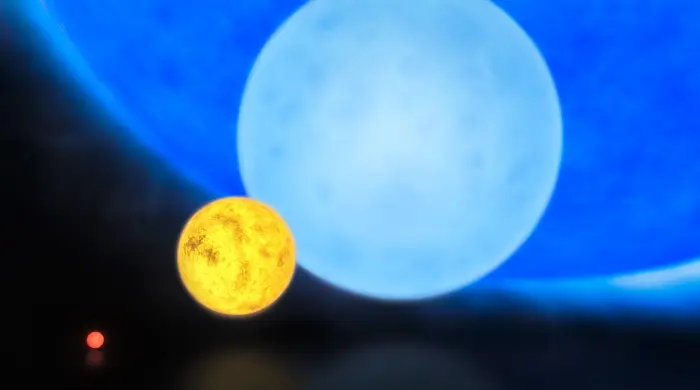
Using a combination of instruments on ESO’s Very Large Telescope, astronomers have discovered the most massive stars to date, some weighing at birth more than 300 times the mass of the Sun, or twice as much as the currently accepted limit of 150 solar masses. This artist’s impression shows the relative sizes of young stars, from the smallest “red dwarfs”, weighing in at about 0.1 solar masses, through low mass “yellow dwarfs” such as the Sun, to massive “blue dwarf” stars weighing eight times more than the Sun, and the star named R136a1. Image credit: ESO/M. Kornmesser (CC BY 4.0)
Mass
R136a1 has a mass of 196 solar masses (169 – 230 solar masses) and is one of the most massive stars known. The value was derived in a 2022 study based on observations with the Zorro speckle imager on the Gemini South telescope.
Only the Wolf-Rayet star BAT99-98 (226 M☉) has a higher estimated mass than R136a1. BAT99-98 also lies in the Tarantula Nebula, near the star cluster R136.
Previous observations gave even higher estimates of the mass of R136a1. Observations with the Hubble Space telescope in 1998 yielded an evolutionary mass of 215 solar masses. An earlier study using ultraviolet spectroscopy found an initial mass of 325 solar masses and a current mass of 315 solar masses.
Like all Wolf-Rayet stars, R136a1 is suffering enormous mass loss – 1.6 × 10−4 M☉ per year – through a strong stellar wind with a velocity of about 2,600 km/s. The star’s exceptionally hot photosphere is accelerating material away from the stellar surface, resulting in a mass loss rate more than a billion times that of the Sun. R136a1 is believed to have lost 35 solar masses of its initial mass.
From 2010 to 2020, R136a1 was identified as the most massive known star, as well as the most luminous.
In 2010, a team of astronomers led by Paul Crowther of the Department of Physics and Astronomy, University of Sheffield, used archival Hubble Space Telescope (HST) and Very Large Telescope (VLT) spectroscopy to analyze the hydrogen-rich Wolf-Rayet stars in the R136 cluster and the nebula NGC 3603. They reported that four stars in R136 had initial masses of 165 – 320 solar masses, which exceeded the accepted stellar mass limit of 150 solar masses. They found an initial mass of 320 solar masses for R136a1.
In 2014, a comprehensive survey of Wolf-Rayet stars in the Large Magellanic Cloud (LMC) identified a new record holder, BAT99-98, with a current mass of 226 solar masses and a large margin of error.
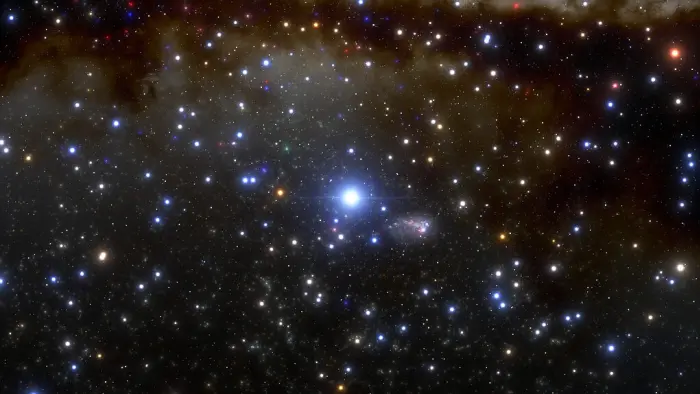
This is an illustration of R136a1, the largest known star in the Universe, which resides inside the Tarantula Nebula in the Large Magellanic Cloud. Image credit: NOIRLab/NSF/AURA/J. da Silva/Spaceengine (CC BY 4.0)
Luminosity
R136a1 has a luminosity of 4,677,000 Suns. It generates more energy in four seconds than the Sun does in a year. If it replaced the Sun in the centre of the solar system, R136a1 would shine at magnitude -40 when seen from Earth. From Proxima Centauri, it would be as bright as the full Moon.
R136a1 and its Tarantula Nebula neighbour BAT99-98 are among the most luminous stars known. BAT99-98 shines with 5,012,000 solar luminosities and may only be outshone by V4650 Sagittarii in the Quintuplet Cluster near the Galactic Centre. V4650 Sagittarii is a luminous blue variable (LBV) with an estimated luminosity between 1,770,000 – 7,943,000 times that of the Sun.
R136a1 produces around 7 percent of the ionizing flux of the entire Tarantula Nebula. It would take 70 main sequence stars of the spectral type O7 to produce the same output.
Life cycle
It is uncertain whether R136a1 formed only by accreting material from a molecular cloud or by stellar merger. Astronomers believe that star formation by accretion predicts an upper limit of around 150 solar masses before the star’s radiation prevents further accretion of material. R136a1 exceeds this limit, which has led astronomers to propose that it may have formed in a merger of a massive binary system.
The future evolution of R136a1 depends on the amount of mass it can lose. Astronomers believe that WNh stars evolve into luminous blue variables (LBVs) when they exhaust the supply of hydrogen at their cores. Stars that are convective enough may develop directly into hydrogen-poor Wolf-Rayet stars when they start fusing helium at their cores. In this phase, these stars lie on the Zero Age Helium Main Sequence (He-ZAMS).
As they continue to burn helium, they keep experiencing high mass loss and carbon and oxygen accumulate in their cores, resulting in a WC (carbon-oxygen) spectrum. As helium burning comes to an end after several hundred thousand years, the core temperature rises and, combined with heavy mass loss, it causes an increase in luminosity. The star’s spectral type becomes WO as the emission of ionized oxygen becomes dominant.
The fusion of heavier elements in the final stages of the life cycle lasts only a few thousand years. R136a1 will eventually lose most of its mass, keeping a little more than 50 solar masses, with only 0.5 solar masses of helium left around the core.
In the end, R136a1 will produce a carbon-oxygen core more massive than 1.4 solar masses and suffer a core collapse. A carbon-oxygen core with between 64 and 133 times the Sun’s mass becomes exceptionally hot. As the temperature and gamma rays increase, an increasing amount of gamma ray energy will be absorbed in creating electron-positron pairs. Eventually the stellar core will lose stability in a runaway reaction that will produce gamma rays at an increasing rate and the annihilation of the electron-positron pairs will become insufficient to prevent further contraction of the stellar core. As a result, the star goes out as a pair-instability supernova (PISN).
Pair-instability supernovae occur in stars with very low metallicity that do not lose enough mass to keep their cores below a mass of 64 solar masses.
However, astronomers found that the predicted carbon-oxygen core of R136a1 will be below 50 solar masses, making a pair-instability supernova unlikely.
Instead, the star may develop an iron core and go out as a type I supernova. If the iron core is particularly massive, the star may collapse into a black hole with no visible supernova event, or into a neutron star. Astronomers believe that due to its mass the star will collapse directly into a black hole.
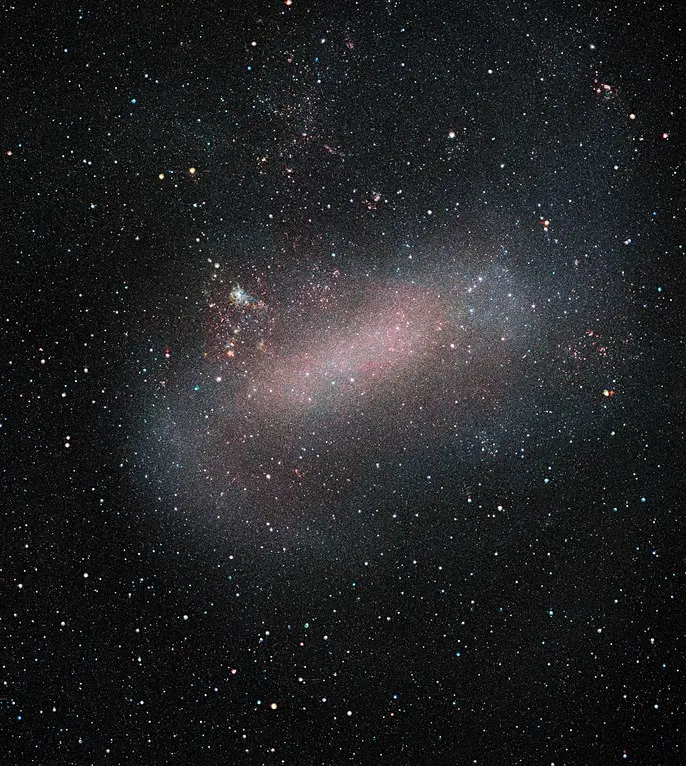
ESO’s VISTA telescope reveals a remarkable image of the Large Magellanic Cloud, one of our nearest galactic neighbours. VISTA has been surveying this galaxy and its sibling the Small Magellanic Cloud, as well as their surroundings, in unprecedented detail. This survey allows astronomers to observe a large number of stars, opening up new opportunities to study stellar evolution, galactic dynamics, and variable stars. Image credit: ESO/VMC Survey (CC BY 4.0)
R136
R136a1 is the brightest member of R136 (RMC 136). R136 is the central concentration of stars in the NGC 2070 open cluster at the heart of the Tarantula Nebula. It contains 72 hot blue O-type stars and Wolf-Rayet stars within 5 parsecs. The high concentration of young, exceptionally massive stars qualifies R136 as a starburst region.
The cluster produces most of the energy that ionizes the Tarantula Nebula. It is believed to be about 1.5 million years old. It may evolve into a globular cluster in the future.
R136 contains several of the most massive and luminous stars known in the Milky Way, including R136a1 (196 M☉, 4,677,000 L☉), R136a2 (151 M☉, 3,548,000 L☉), R136a3 (155 M☉, 3,631,000 L☉), R136a7 (127 M☉, 2,291,000 L☉), and R136c (142 M☉, 3,800,000 L☉). All these are Wolf-Rayet stars except R136a7, which is a hot, blue O-type giant.
The R136a system at the centre of the cluster contains at least 12 stars. R136a1 and R136a2, the brightest members of the cluster, are separated by 5,000 astronomical units.
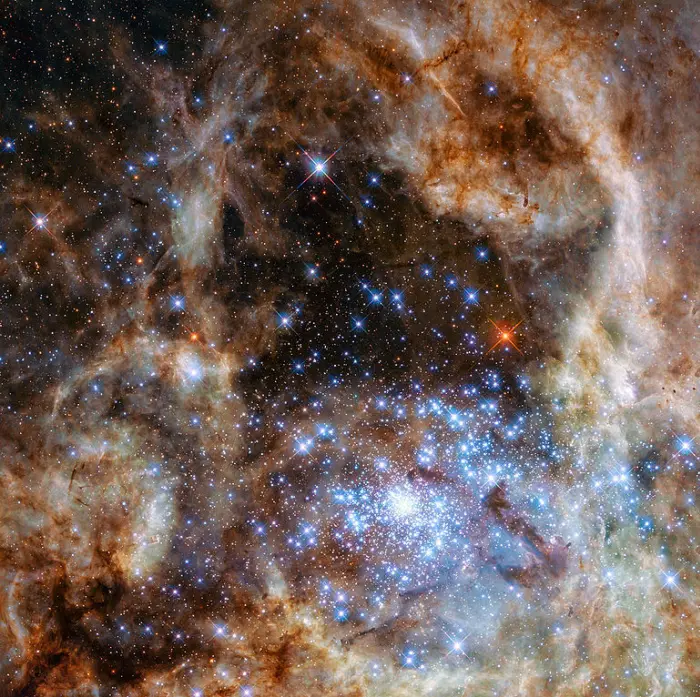
The image shows the central region of the Tarantula Nebula in the Large Magellanic Cloud. The young and dense star cluster R136 can be seen at the lower right of the image. This cluster contains hundreds of young blue stars, among them the most massive star detected in the Universe so far. Using the NASA/ESA Hubble Space Telescope astronomers were able to study the central and most dense region of this cluster in detail. Here they found nine stars with more than 100 solar masses. Image credit: NASA, ESA, Paul Crowther (University of Sheffield) (CC BY 4.0)
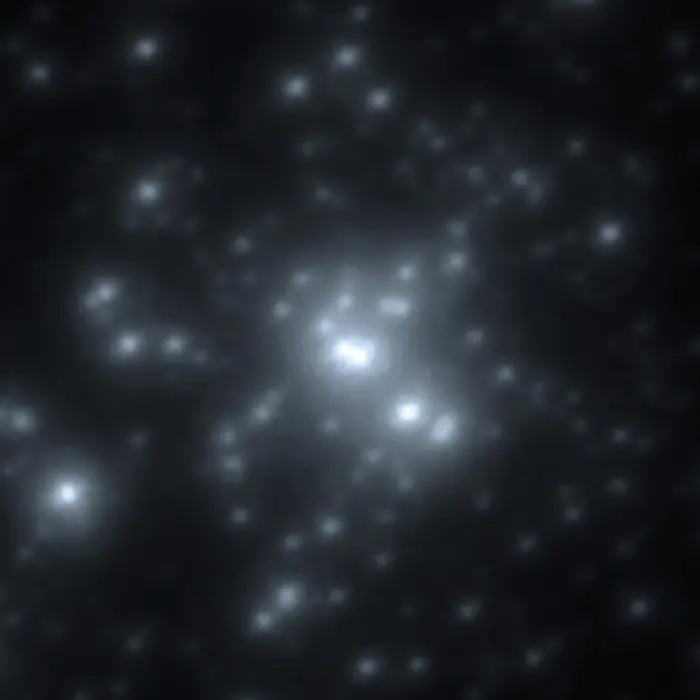
A near-infrared image of the R136 cluster, obtained at high resolution with the MAD adaptive optics instrument at ESO’s Very Large Telescope, provides unique details of its stellar content. At birth, the three brightest stars each weighed more than 150 times the mass of the Sun. Image credit: ESO/P. Crowther/C.J. Evans (CC BY 4.0)
NGC 2070
NGC 2070 is a bright, large open cluster at the centre of the Tarantula Nebula. With an apparent magnitude of 7.25 and an apparent size of 3.50 by 3.50 arcminutes, it can be observed in small telescopes. It is listed as Caldwell 103 in the Caldwell catalogue of deep sky objects visible in amateur telescopes.
Tarantula Nebula
The Tarantula Nebula (30 Doradus) is a vast H II region in the Large Magellanic Cloud (LMC). The nebula has an angular size of 40 by 25 arcminutes and an apparent magnitude of 8. It can be easily observed in binoculars and small telescopes.
The Tarantula is the most active starburst region known in the Local Group of galaxies, as well as one of the largest. It is an exceptionally luminous object, containing multiple clusters of massive young stars that energize and illuminate the surrounding clouds of dust and gas.
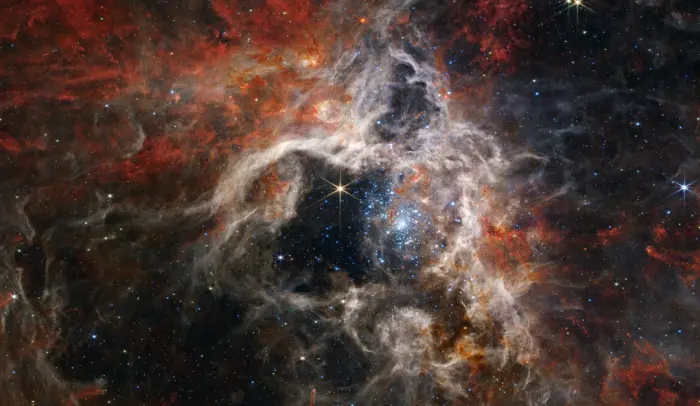
The James Webb Space Telescope reveals details of the structure and composition of the Tarantula Nebula, as well as dozens of background galaxies. Stellar nursery 30 Doradus gets its nickname of the Tarantula Nebula from its long, dusty filaments. Located in the Large Magellanic Cloud galaxy, it’s the largest and brightest star-forming region near our own galaxy, plus home to the hottest, most massive stars known. The center of this image, taken by Webb’s Near-Infrared Camera instrument (NIRCam), has been hollowed out by the radiation from young, massive stars (seen in sparkling pale blue). Only the densest surrounding areas of the nebula resist erosion, forming the pillars that appear to point back towards the cluster of stars in the center. The pillars are home to still-forming stars, which will eventually leave their dusty cocoons and help shape the nebula. Image credit: NASA, ESA, CSA, STScI, Webb ERO Production Team (CC BY 2.0)
Facts
R136a1 is one of the objects catalogued under the designation RMC 136 by a group of astronomers at the Radcliffe Observatory in Pretoria, South Africa, in 1960. The astronomers measured the brightness and spectra of bright stars in the Large Magellanic Cloud. They listed RMC 136 as the central “star” in the 30 Doradus nebula, noting that it was probably a multiple star system. Subsequent observations revealed that R136 was located at the centre of a giant H II region, a very active star forming site.
R136 was resolved into three components using the European Southern Observatory’s (ESO) 3.6 m telescope at the La Silla Observatory in Chile in 1979. These components were designated R136a, R136b, and R136c.
The nature of R136a was a matter of debate for years. The component appeared several million times more luminous than the Sun. In the early 1980s, astronomers proposed that R136a was a single star with a mass 3,000 times that of the Sun. This was the mass required to stabilize a single star against the radiation pressure that comes with its enormous luminosity. This seemed a more likely explanation than the presence of multiple stars within only half a parsec.
R136a was resolved into a dense cluster of at least eight stars by Weigelt and Beier using speckle interferometry in 1985. These eight components lie within 1 arcsecond of the core of R136. R136a1 is the brightest component. The findings were published in Astronomy and Astrophysics in September 1985.
In 1992, observations with the Hubble Space Telescope (HST) resolved R136a into at least 12 components, three of which are Wolf-Rayet stars. Hubble’s Wide Field and Planetary Camera (WFPC) detected more than 200 exceptionally luminous stars in R136. Astronomers did not detect any red supergiant stars, indicating that the cluster is still very young and its stars have not yet had enough time to evolve.
In 1995, the more advanced Wide Field and Planetary Camera 2 (WFPC 2) provided astronomers with more insights into the region, allowing them to study more than 3,000 stars within 4.7 parsecs of R136a and 46 very massive stars within half a parsec.
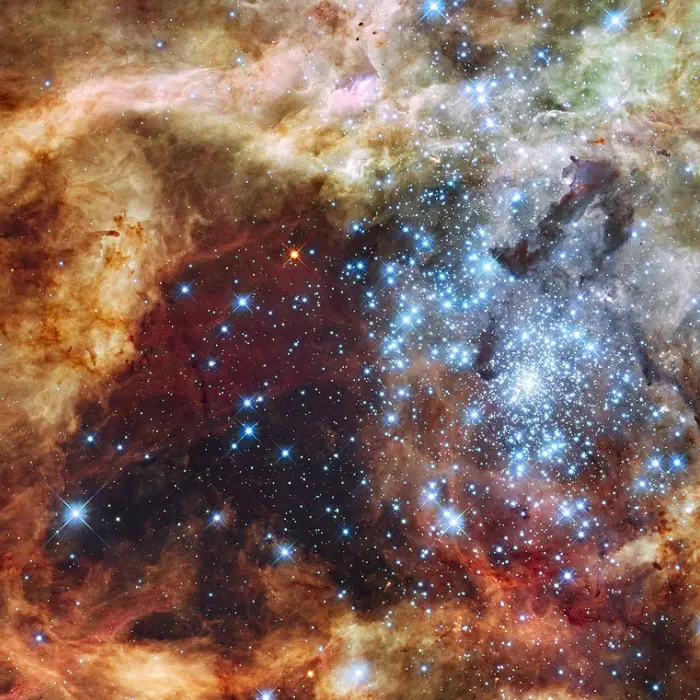
This is a view of the largest stellar nursery in our local galactic neighborhood. The massive, young stellar grouping, called R136, is only a few million years old and resides in the 30 Doradus Nebula, a turbulent star-birth region in the Large Magellanic Cloud (LMC), a satellite galaxy of our Milky Way. There is no known star-forming region in our galaxy as large or as prolific as 30 Doradus. Many of the diamond-like icy blue stars are among the most massive stars known. Several of them are over 100 times more massive than our Sun. These hefty stars are destined to pop off as supernovas in a few million years. This image, taken in ultraviolet, visible, and red light by Hubble’s Wide Field Camera 3, spans about 100 light-years. The nebula is close enough to Earth that Hubble can resolve individual stars, giving astronomers important information about the birth and evolution of stars in the universe. The Hubble observations were taken October 20-27, 2009. The blue color is light from the hottest, most massive stars; the green from the glow of oxygen; and the red from fluorescing hydrogen. Image credit: NASA, ESA, F. Paresce (INAF-IASF, Bologna, Italy), R. O’Connell (University of Virginia, Charlottesville), and the Wide Field Camera 3 Science Oversight Committee (CC BY 4.0)
Name
R136a1 does not have a proper name. It is commonly referred to as R136a1 or RMC 136a1. The designations come from the Radcliffe Observatory Magellanic Clouds Catalogue (RMC), published in 1960.
Location
R136a1 is the brightest member of the R136 cluster in the larger Tarantula Nebula in the Large Magellanic Cloud. The Large Magellanic Cloud is visible to the unaided eye. It can be found using Sirius and Canopus, the brightest stars in the sky. A line drawn from Sirius through Canopus leads to the LMC.
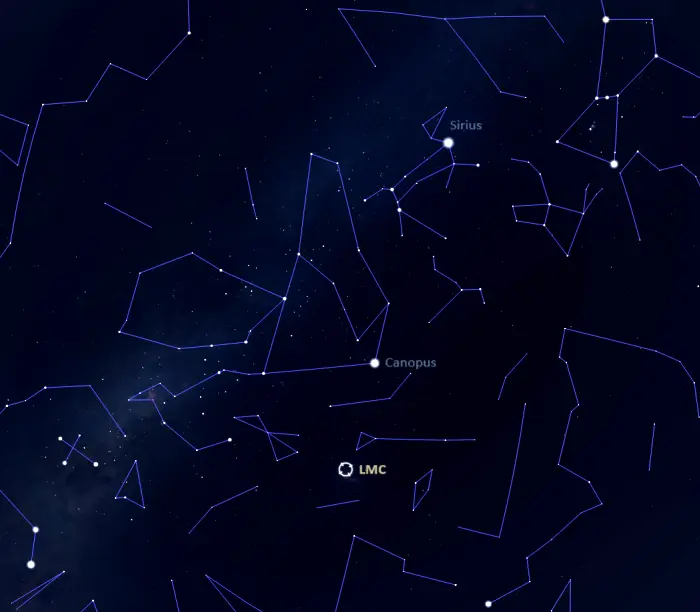
The location of the Large Magellanic Cloud, image: Stellarium
The Tarantula Nebula marks the dwarf galaxy’s south-eastern corner and the star cluster R136 lies at the centre of the nebula.
R136 has an apparent magnitude of 9.50 and is visible in binoculars and small telescopes, but R136a1 is around 100 times fainter than the cluster and cannot be seen even in large ground-based telescopes. It can only be resolved using speckle interferometry or a space telescope.
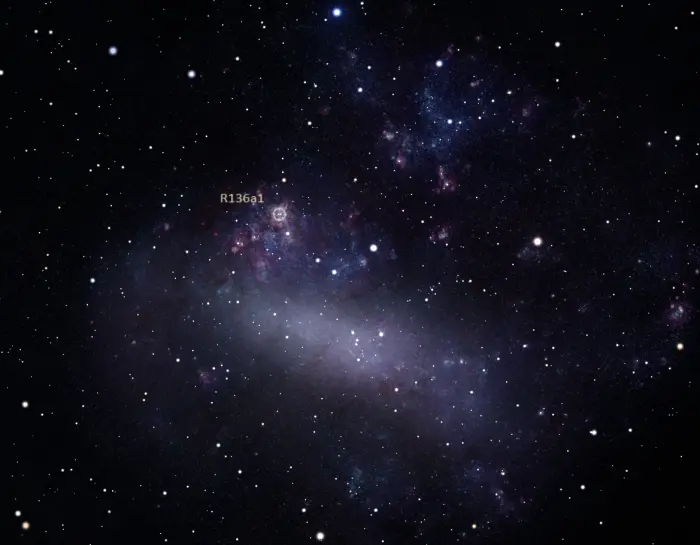
The location of R136a1 in the Large Magellanic Cloud (LMC), image: Stellarium
At declination -69°, the Tarantula Nebula and R136 never rise for observers north of the latitude 20-21° N, and they only appear low above the horizon for observers in the northern tropical latitudes. In the southern hemisphere, the Large Magellanic Cloud is circumpolar from locations south of the 20th parallel south and can be seen throughout the year.
The best time of the year to observe the stars and deep sky objects in Dorado is in January, when the constellation appears higher in the sky in the early evening.
Constellation
R136a1 is located in the southern constellation of Dorado (the Dolphinfish). Dorado occupies an area of 179 square degrees and is the 72nd largest constellation in the sky (out of 88). is one of the several dim southern constellations appearing between the first-magnitude Canopus and Achernar.
The constellation Dorado was created by the Dutch-Flemish astronomer Petrus Plancius in the 16th century based on observations of Dutch navigators who had mapped the southern skies during their travels in the southern hemisphere.
The white giant Alpha Doradus, the brightest star in Dorado, has an apparent magnitude of 3.27. The variable supergiant Beta Doradus is the only other star in the constellation that is brighter than magnitude 4.0.
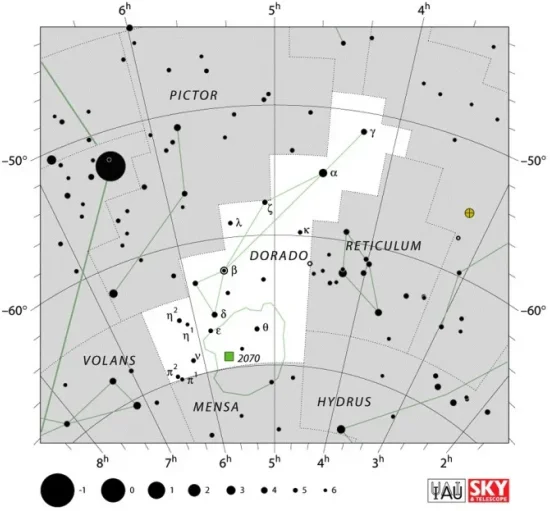
Dorado constellation map by IAU and Sky&Telescope magazine
Other notable stars in the constellation include the luminous blue variable S Doradus, the variable red giant R Doradus, and the pulsating variable Gamma Doradus.
Several other interesting stars reside in the Tarantula Nebula, including the supergiants WOH G64, WOH S140, and Melnick 42, and the Wolf-Rayet stars BAT99-98, VFTS 682, R136a2, and R136a3. These are some of the most massive and luminous stars known.
The best-known deep sky objects in Dorado reside in the Large Magellanic Cloud. They include the Tarantula Nebula (30 Doradus), the Ghost Head Nebula (NGC 2080), the emission nebula N44, and the Seagull Nebula (NGC 2032).
The 10 brightest stars in Dorado are Alpha Doradus (mag. 3.27), Beta Doradus (mag. 3.46 – 4-08), Gamma Doradus (mag. 4.25), Delta Doradus (mag. 4.34), HD 40409 (mag. 4.65), Zeta Doradus (mag. 4.82), Theta Doradus (mag. 4.82), Eta2 Doradus (mag. 5.01), Nu Doradus (mag. 5.06), and Epsilon Doradus (mag. 5.11).
R136a1
| Spectral class | WN5h |
| B-V colour index | 0.03 |
| Apparent magnitude | 12.23 |
| Absolute magnitude | -8.18 |
| Distance | 163,000 light-years (49,970 parsecs) |
| Mass | 196 M☉ (169 – 230 M☉) |
| Luminosity | 4,677,000 L☉ |
| Radius | 42.7 R☉ |
| Temperature | 46,000 K (43,625 – 47,250 K) |
| Age | 1.14 million years (1 – 1.31 million years) |
| Rotational velocity | 160 km/s |
| Surface gravity | 3.65 cgs |
| Constellation | Dorado |
| Right ascension | 5h 38m 42.39s |
| Declination | −69° 06′ 02.91″ |
| Names and designations | R136a1, RMC 136a1, BAT99 108, NGC 2070 MH 498, HSH95 3, WO84 1b, CHH92 1, P93 954 |